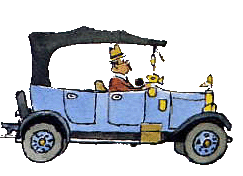


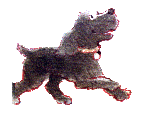 "Hello again dear visitor, I am glad you followed me here because now I would like to share with you how Val became an artist.
"Hello again dear visitor, I am glad you followed me here because now I would like to share with you how Val became an artist.
2. Schooldays.
3. Moving to England.
4. The Art Student.
5. Val's Early Working Years.
I did mention earlier that Val was not born in the UK and the book title below will
give you a big clue as to exactly where he was born. If you want to have a closer look
Val was born Balint Stephen Biro, ( Val because Valentine is the nearest English version of Balint ) in the city of Budapest, in Hungary, on the 6th October 1921. His father was a lawyer and Val describes his mother as being a 'thoroughly modern woman' of the 20s and 30s era. A gifted linguist and pianist she enjoyed Budapest life to the full. Both parents came from country stock with the result that Val, and his sister Lilla, spent all their summers enjoying the idyllic Hungarian countryside. Discussing them he says; "Summer holidays were something else. They belonged to that vanished world of ineluctable delights that only children can ever experience..... endless hot summer days spent playing in the garden, or out in the fields, driving in a trap, swimming parties in the lake."
Given that his country was in the aftermath of World War I and, during the 20s and 30s, watching the rise of Nazism in Germany Val's, later, remark that 'memory is mercifully selective' is particularly relevant.
In his autobiographical notes Val describes his birthplace thus ; " Budapest was then - and still is - a beautiful city. Straddling the Danube, connected by graceful bridges, dominated by the hills of Buda and the Royal Palace, encircled by Boulevards on the Pest side to rival those of Paris, and studdied with baroque churches, a rococo opera house, classical museums, and trees everywhere: it is a city that gives one a sense of well-being"
"Throughout my childhod we lived in a big flat, overlooking the Houses of Parliament (a superb Gothic pastiche ) with a glimpse of the Danube beyond"
Return to the top of the page.
On his eleventh birthday he exchanged his 'two dessicated spinsters' for a large school of seven hundred pupils run by the monks of the Cistercian order. One of the three great monastic schools of Hungary, learning was a serious business, the discipline was strict and beating the order of the day.
One incident stand out vividly in Val's mind. In a maths class he drew a caricature of the teacher and showed it to his friend George. George sniggered. The master called the two boys out and looked at the drawing. Val describes what happened next; He put it down, grabbed us both by the hair and banged our heads rythmically together. As he did so he spoke in the same rythm; ' This young man will go far. But not, repeat NOT during my lessons! My head was still whirling as I sat down at last but it must have been then that I decided to become an artist."
The politics of the mid thirties, dominated by the rise of Nazism and Fascism slowly came to increasingly influence the people of Hungary and Val's father, recognising what was happening, arranged in 1939, for his eighteen year old son to go to London to study art. Val never saw his father again. Val hero worshipped his father who sadly died in 1944 only two days before the Gestapo called to arrest him as a political suspect.
Return to the top of the page.
" The centre of an Empire, the fog-enshrouded home of Sherlock Holmes, A.J.Cronin and John Buchan,where everybody smoked a pipe and changed for dinner; the home of Jeeves and Lord Emsworth and large policemen."
The joy of being in England continued all that 'magical' summer of 1939 as the young Val stayed at Polperro with the McCloy family whose son had spent the previous summer with the Biro's in Budapest. They bathed, went fishing and exploring and played gin-rummy.
Fortunately our developing artist must not have been considered a threat to national security because he was not interned, but allowed to enrol in the Central School of Arts in London. This was soon evacuated to the Midlands and Val spent the next three years of his course in Northampton.
Return to the top of the page.
He states,
"I came to realise that there was more to art than drawing funny faces. First I had to learn to draw properly. and the best place for that was in the Life Drawing class. With a strict Cistercian upbringing behind me, and a family that never dreamt of discussing
Admittedly, the serious concentration of the other students around me, and the calm professionalism of the model herself helped, while the difficulty of the task of drawing concentrated my mind on higher things. I came to realise ( much later ) that good drawing is not only a technical but an emotional matter: that in fact it is essential for the artist to be in a heightened state of emotional awareness. Which, whether one likes to admit it or not, is almost akin to sexual arousal, irrespective of the subject in front of one: be it a nude model, a bunch of grapes, or a village church"
Val considers himself very fortunate in the tutors that he had at the Art College. Artists of the standing of Noel Rooke, Bernard Meninsky ( The nude drawing above is one of his works.) and above all, the most stimulating of tutors on the graphic side, John Farleigh.
"a noted wood-engraver with a sparkling set of engravings for Bernard Shaw's 'The Adventures of The Black Girl in Her Search for God',( Constable 1932.) to his credit. (Copyright permission for this illustration is curently being sought. -----------. Click on the image to appreciate the exquisite detail of a fullsized reproduction.) Val goes on to say, "I was so fired by his example that I promptly equipped myself with gravers, a sandbag, and some boxwood, and settled down to learn this difficult, slow, but hugely satisfying craft.( In my third year I produced my first illustrated book with engravings, printed on the school's own press, and it still looks good.")
Exciting as wood-engraving was Val soon realised that it was time consuming for an artist intent on making his living from this type of work and duly found that the nearest equivalent technique, scraperboard, meant that he could produce four drawings in the time it would take to produce one wood-engraving. A technique that was to prove invaluable during his working life.
Commenting on his student days Val says,Life as an art student - with all its youthful traumas and fits of utter depression - was pleasant and liberating. We had endless discussions about life, art, and politics and how to put the world to rights...........Time passed swiftly, and soon it was my final year and I had enough work in my portfolio to start showing it around to get commissions."
Return to the top of the page.
Charles Rosner who ran the Sylvan Press did so virtually single handed. This was very much to Val's advantage as he learned every aspect of the book publishing trade. Editorial, production, printing and marketing. A valuable breadth of experience that would serve him well in the future.
Rosner gave him his first commissions for illustrating books. Two early examples of this work being, 'Worlds without End' by Denys Val Baker and 'Private Gallery' by Paul Tabori.
On April 14th 1945, aged twenty four, Val married Vivien Wooley and their daughter Melissa was born in 1951.
From 1946 to 1948 Val had a new job as production manager and art director for C.& J. Temple. There he came into contact with, and his work was influenced by, a well known illustrator, Arthur Wragg.
About Wragg Val says,
" Working in the 'New Romantic' manner of the forties, he became a profound influence on my work. A man of deep sensitivity and intelligence, a diminutive figure of charm and fun - we called him Raggybag.........Although Arthur Wragg's work was modern he was imbued with a love of the seventeenth and eighteenth centuries, and he opened my eyes to the art of that period."
It was Wragg who found Val's next job for him and from 1948 to 1953 he was employed by
Val says.
"Lehman devoted his considerable energies to the promotion of new talent for his own company, which he sought out on both sides of the Atlantic. He was the first to publish novelists who would become household names later on; Paul Bowles, Gore Vidal, Tennessee Williams, Susan Yorke, Nikos Kazantzakis( 'Zorba the Greek'); poets like Sitwell, Fuller, Alan Ross, George Barker; he even discovered cookery writers like Fanny Craddock and Elizabeth David. His was truly a distinquished list"
Val's job, at Lehmann's, was, as art director, to look after book production. He was thoroughly motivated by his job but did not wish to stop the illustration and design work that he was doing ,in his own time, for other firms. Lehmann not only encourage this but gave Val commissions of his own books. Within the year Lehmann arranged the work so that Val could work a four day week and have the rest of the time for his own interests.
"My own workload increased all the while, consisting mostly of book jackets and designs for advertising agencies. I also received commissions to illustrate books ( all of them at that time in black and white), such as 'The Last Days of Pompei' by Bulwer-Lytton, 'Pilgrim's Progress' by Bunyan, and that enchanting novella by Enid Bagnold, 'Serena Blandish. "
'The Shadow and the Peak', shown right, was published in 1949 and is,therefore, an example of Val's early freelance works.
Life continued at Lehmann's in the same vein until that fateful day in 1953 when they went out of business because the parent company decided that their books were not making enough money. Lehmann refused to compromise his high standards by being prepared to go 'down market' just to attract more sales and the business simply had to go.
Always aware of the welfare of his employees, Lehmann arranged new jobs with magazines and other publishers for his staff. This left Val on the horns of a dilemma. He describes it thus,
"I was at a crossroads. Should I take up a job which John now suggested, get a regular income, perhaps achieve a directorship later on, and look forward to retirement at sixty-five on a good pension? Or should I resign from regular employment, remain a full-time freelance artist, do the work I was passionately addicted to, with no assurance of income or pension? I discussed it with Vivien, and she was quite clear as to what I should do. So next day I resigned. "
Return to the top of the page.
It turned out to be a good time to be going freelance as shortly Val was innundated with new commissions. He describes those days thus,
He goes on however to say,
....."The fact remains that from that first day of freedom I had to keep my nose firmly glued to the drawing board. ........ The new work consisted mostly of book jackets. I
would be sent a typescript of the book, given a rough brief and, most importantly a deadline. I would then settle down to read the book - or as much of it that would give me the subject, the characters, the settings, the outline of the plot, and the relevance of the title -- unless the book was like 'The Go-Betweens' or a 'Hornblower', in which case I would read every syllable and ruin my schedule -- and then do a 'rough' in colour. The publisher would look at it ( The author seldom if ever ) and would either accept, criticise or reject it. Once accepted the finished artwork was done."
During this period Val designed book jackets for many famous, and not so famous, writers. Among the well-known were C.S.Forester's 'Hornblower' novels, Monica dickens, Joyce Cary, Naomi Jacobs, Raphael Sabatini, Evelyn Waugh, Norah Lofts, Noel Coward, Nevil Shute. Shute wrote to Heinemann to thank them for 'a jacket artist who so evidently knew the Australian background at first hand'. Val has never been there but this incident shows how he can sensitively pick up information from 'the bare words' and create from them accurate and emotively strong visual imagery.
In his autobiographical notes Val comments.
"While the problem set for the jacket artist is essentially the same -- to encapsulate the whole book into a single image and to combine it with suitable lettering, making the whole into a memorable poster to stand out on a bookstall -- the task of an illustrator is much deeper, and a lot more permanent. So naturally I welcomed the chance to illustrate more and more books 'to do'. They included travel and country books, cookery books and short stories, and I began to get more children's books to illustrate too. My attitude towards these had changed by then, and I came to realise how important they were for the children themselves, besides giving the artist such a wide creative scope. Those high-falutin' art-school attitudes were well and truly over at last."
While the work flowed in unceasingly there was one are, important to any illustrator, that Val simply could not break in to. That was the 'Radio Times'. For an artist to have work regularly accepted by the Radio Times was the sign that this illustrator had reached the top of his profession.
Val in talking about the 'Radio Times' says,
"Ever since the late twenties this magazine had a unique reputation for high-quality illustrations in black and white by some of the foremost illustrators of the day. By the early fifties it stood at the height of its reputation, with weekly circulation of over ten million, so that everybody would see your work in it, if only you could get in! I first went to see the editor when still at art school, but he dismissed me. I tried again a few years later, but he remained totally disinclined to avail his magazine of my services. So I gave up and tried to forget all about it."
Val takes up the story,
"He warned me that as there was no time to do a rough, I'd better start on the finished drawing straight away and let him have it by Monday morning -- this was Friday afternoon. I accepted, of course, with delight -- and trepidation, because I knew that if I muffed it, there was no time for a revise, and that I would be finished before I ever started.
There never was a three quarter inch drawing that carried so many hopes on its column-width shoulders, and I took it in on Monday morning. Usherwood liked it and promptly asked me to do another drawing for the following week's edition.
That was the beginning of a twenty-one-year association with the Radio Times during which time I did a drawing nearly every week."
1.His Childhood
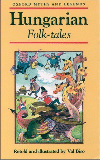 at the dragons and other weird creatures on the book cover then click on the picture.
at the dragons and other weird creatures on the book cover then click on the picture.
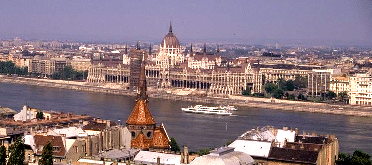
 "The picture on the right shows the Parliament building and, going by Val's description and if my sense of direction is correct, we should be looking over the Danube towards the area where Val lived. To the left of the Parliament building"
"The picture on the right shows the Parliament building and, going by Val's description and if my sense of direction is correct, we should be looking over the Danube towards the area where Val lived. To the left of the Parliament building"
1. Schooldays
Val's small primary school seems to have been predominantly a negative experience. He describes it as being "run by two dessicated spinsters in a strict and endless routine of learning by rote. I hated it..." Art class twice weekly was different and drawing and 'messy, modelling in clay excited the budding artist.
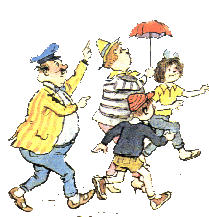 Val continued drawing and found that he had the knack of drawing funny people one project being a football crowd. Political cartoons such as were created by Strube of the Daily Express were a natural development.
Val continued drawing and found that he had the knack of drawing funny people one project being a football crowd. Political cartoons such as were created by Strube of the Daily Express were a natural development.
 "And he still thoroughly enjoys drawing 'funny people' as this illustration from 'Gumdrop At Sea' indicates."
"And he still thoroughly enjoys drawing 'funny people' as this illustration from 'Gumdrop At Sea' indicates."
1. Moving to England
Val left for England in July 1939 having what he describes as a 'concept' of the country rather than a solid impression of what he was coming to. This concept, built up from his reading of English literature he describes as,
1. The Art Student

"The impact of Art School on Val was memorable and he describes beautifully , in his biographical notes, both the experience of drawing and its deeper emotional meaning."
 anything more intimate than the filling of a sandwich, I found myself face to face-or buttock- with a model in all her nakedness for the first time. It was a delightful shock and, once my hand holding the pencil had stopped trembling, I found to my surprise that I was able to draw the object of my gaze - and draw it rather well.
anything more intimate than the filling of a sandwich, I found myself face to face-or buttock- with a model in all her nakedness for the first time. It was a delightful shock and, once my hand holding the pencil had stopped trembling, I found to my surprise that I was able to draw the object of my gaze - and draw it rather well.
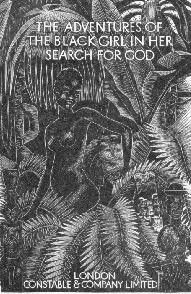 Val's main subject at Art School was Illustration. His first impression of the power of words and pictures was his reading of the, rather frightening , tale of Struwelpeter and it was through Farleigh that he developed a deep appreciation of the illustrators art. Farleigh, he notes, was,
Val's main subject at Art School was Illustration. His first impression of the power of words and pictures was his reading of the, rather frightening , tale of Struwelpeter and it was through Farleigh that he developed a deep appreciation of the illustrators art. Farleigh, he notes, was,1.Val's Early Working Years
And so in 1942 Val's working life commenced. He was fortunate to get work as a studio assistant with the Sylvan press at the princely sum of three pounds a week. With a war on and his being considered an 'Enemy Alien' he was not allowed to join the forces but worked ,at nights, as a part time fireman, in London, for the duration of the war.
 "It is wonderful to have been able to obtain copies of these books after fifty six years. If you would like to see examples of the wonderful wood engravings that Val did for these books click on the book title."
"It is wonderful to have been able to obtain copies of these books after fifty six years. If you would like to see examples of the wonderful wood engravings that Val did for these books click on the book title."
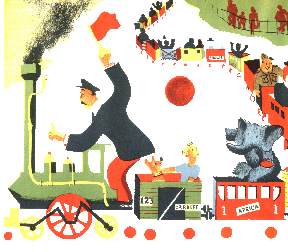 To see how he would cope with illustration using lithography Rosner also gave Val his first commission for a children,s book . The result of this challenge'Bumpy's Holiday', about an elephant who gets a ride on a toy train, was produced. Val comments,
To see how he would cope with illustration using lithography Rosner also gave Val his first commission for a children,s book . The result of this challenge'Bumpy's Holiday', about an elephant who gets a ride on a toy train, was produced. Val comments,
" My illustrations weren't much better, because drawing on zinc plates required a lot more experience than I had at that time. This commission came too soon and I regard it now as a first trial rather than my first book. Also, at that time I did not regard children's books as 'proper' work for a real artist, a view commonly held by most of my contemporaries out of art school."![]() "Thank goodness for Gumdrop. Mr. Oldcastle and me Val later changed his mind. Otherwise !!!!!!!"
"Thank goodness for Gumdrop. Mr. Oldcastle and me Val later changed his mind. Otherwise !!!!!!!"
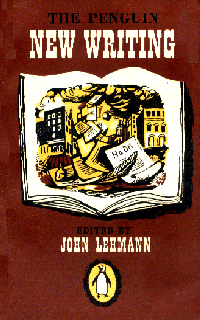 John Lehmann Ltd. During the war Lehmann had been the founder of 'Penguin New Writing, a literary magazine of great influence and reputation. This magazine was considered the measure of contemporary writing and encouraged new talent. Lehmann was at the centre of the artistic elite for that period and the young Val must have found himself in a highly stimulating environment.
John Lehmann Ltd. During the war Lehmann had been the founder of 'Penguin New Writing, a literary magazine of great influence and reputation. This magazine was considered the measure of contemporary writing and encouraged new talent. Lehmann was at the centre of the artistic elite for that period and the young Val must have found himself in a highly stimulating environment.
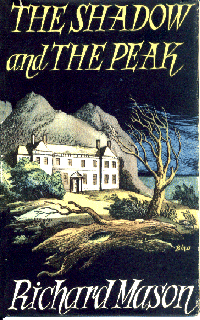 Val Explains,
Val Explains, "An exciting, challenging and daunting step to take, with a wife and a young child to support, but one that was to lead Val in undreamed of directions."
"An exciting, challenging and daunting step to take, with a wife and a young child to support, but one that was to lead Val in undreamed of directions."
1.The Freelance Artist
Val wrote to all the publishers and agencies who knew his work and told them that he was now free to devote all his time to freelance artwork and would they please send him commissions.
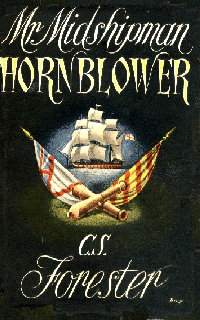 "So I was in business. It was wonderful to wake up in the morning to realise that there was no commuting or office ahead of me, that I need only go downstairs and sit at my own desk, indeed that I need not start work until I felt like it. I could even take the day off if I wanted. What bliss!"
"So I was in business. It was wonderful to wake up in the morning to realise that there was no commuting or office ahead of me, that I need only go downstairs and sit at my own desk, indeed that I need not start work until I felt like it. I could even take the day off if I wanted. What bliss!"
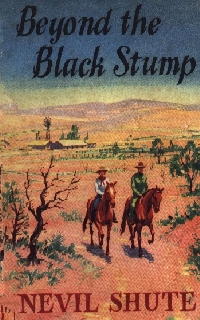 Around 1960 Val estimates that he was probably designing more book jackets for hardback books than any other artist in England.
Around 1960 Val estimates that he was probably designing more book jackets for hardback books than any other artist in England.
 And so the situation remained until one day the phone rang and the new editor of the Radio Times, Ralph Usherwood, asked Val if he would produce a drawing of an angel singing -- one column wide and three quarters of an inch deep.
And so the situation remained until one day the phone rang and the new editor of the Radio Times, Ralph Usherwood, asked Val if he would produce a drawing of an angel singing -- one column wide and three quarters of an inch deep.
 ,
,
 And so, dear reader, this is how Val became an artist. I hope you enjoyed learning about his early life.
And so, dear reader, this is how Val became an artist. I hope you enjoyed learning about his early life.
Click on Gumdrop to return to Val's 'Homepage Links'
